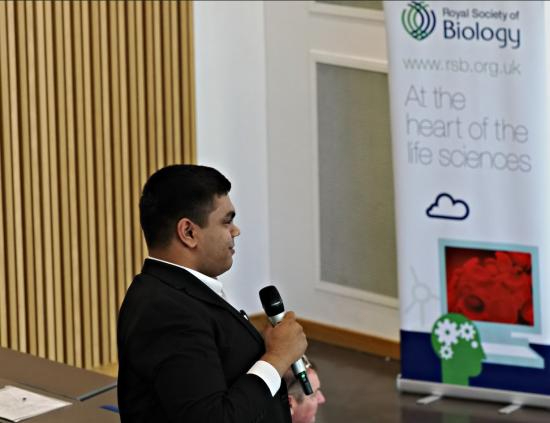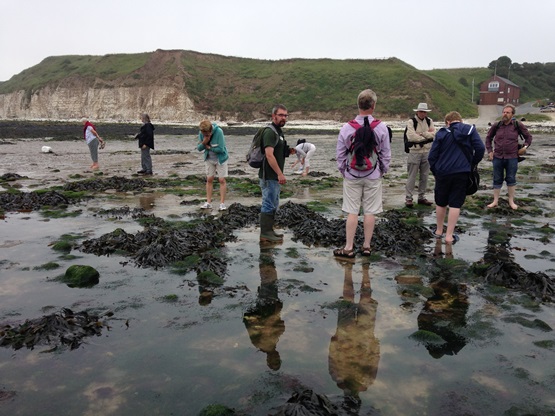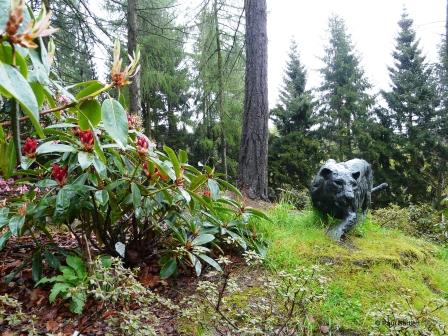Reports
Autumn Symposium “Brewing and Fermentation"
11 November 2023
Fermentation is a biological process long exploited by humans for the production of food and beverages. This symposium focused on the science of brewing, fermentation and nutrition. Our first speaker, Dr Christine Bosch (Associate Professor in Nutrition, School of Food Science & Nutrition, University of Leeds) gave us an excellent introduction to the topic. She described evidence of brewing dating back thousands of years and presented us with a “Periodic Table” of fermented foods currently available. Dr Bosch went on to talk about the fascinating effects of industrialisation on our all-important gut microbiome and the health benefits of eating fermented foods.
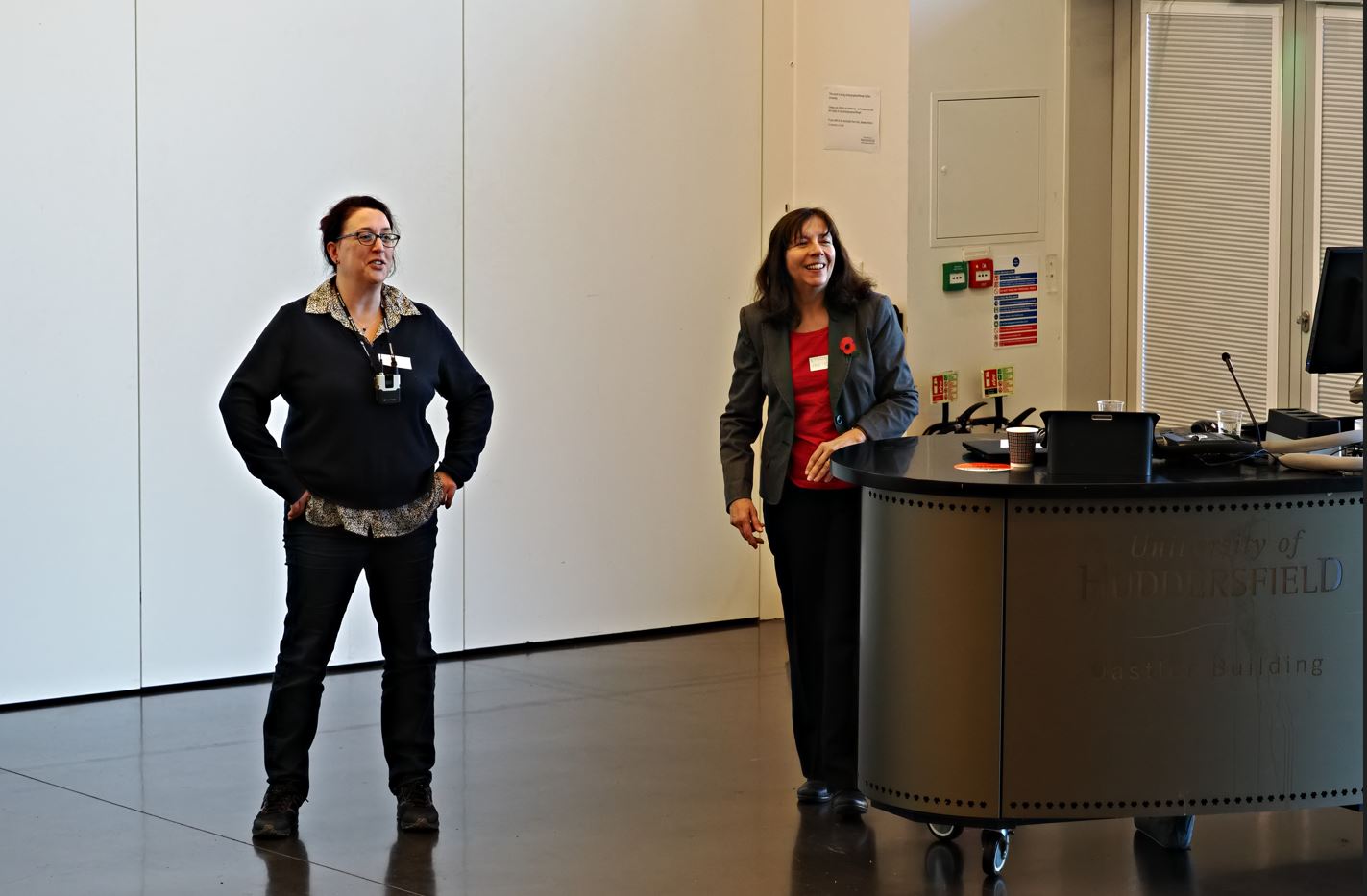
Our following speaker, Dr Claire Monk (General Manager and Brewer at the Wellbeck Brewery, Nottinghamshire) explained how she’d made the transition from scientist in Biochemistry/Microbiology to brewing beer. In a very entertaining talk, she compared the techniques involved in making bread and beer and explained that historically the processes were often linked, as in the bakeries and breweries of medieval monasteries. The audience was given free samples (just of barley, disappointingly to some!) so that we could taste how it became sweeter when acted on by amylase in saliva.
Unfortunately, our final speaker, Matthew Hutchinson (Chemical and Biological Engineering, Entrepreneurial Lead at ReNewFood, University of Sheffield) who had been due to speak about using fermentation to improve the flavours of food, succumbed to flu and was unable to attend. Nevertheless, the Symposium received excellent feedback. The University of Huddersfield hosted the event and provided us with an impressive venue, great support and a delicious buffet lunch.
Dr Lynda Partridge FRSB
Lady Mary Wortley Montagu – Medical Pioneer
15 July 2023
In 1721, Lady Mary Wortley Montagu pioneered the introduction of smallpox inoculation in Britain, some 75 years before Edward Jenner began vaccinating against this deadly disease. The formal unveiling of a ‘blue plaque’ at Wentworth Castle Gardens, near Barnsley, celebrated her contribution to preventative medicine. Lady Mary is memorialised on the site by way of an elegant obelisk, the ‘Sun Monument’, the first monument to be dedicated to the social achievement of a woman in Britain.
A cake-laden reception and talks were held in the exquisite ‘Blue Room’ in the 18th century mansion before the unveiling. History guide, Jenny Rudd, gave a fascinating insight into Mary’s life and achievements.
A self-educated linguist and writer, Mary transgressed the expectations of her gender, whilst exploiting the privilege of her class, to introduce inoculation into fashion amongst the nobility. Finding herself in Constantinople as an ambassador’s wife, Mary witnessed the Turkish folklore practice of smallpox inoculation by elderly women. A victim of smallpox herself, Mary became convinced of inoculations effectiveness in preventing deaths from the disease. Her demonstration of the technique on her daughter in front of eminent physicians promoted lively debate amongst members of the Royal Society and its eventual incorporation into medical practice.
Dr Sarah Haywood-Small from Sheffield Hallam University followed this with an engaging talk, introducing the science behind the development of current vaccines.
Despite heavy showers, the event was a ‘full house’ with over 50 attendees. The plaque is installed on the Long Barn, with sponsorship provided by the British Society of Immunology.
The gardens are under the custodianship of the National Trust, Northern College and Barnsley Museums.
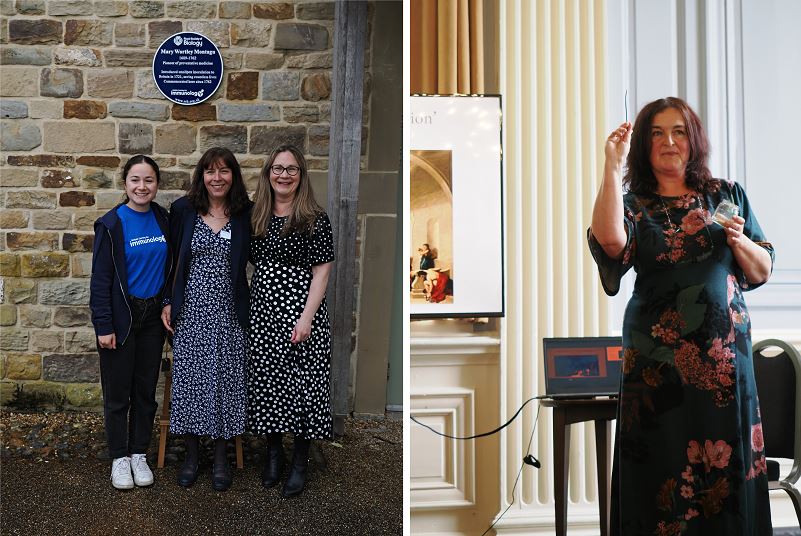
Left: The blue plaque celebrating the achievements of Lady Mary Wortley Montagu on the wall of the Long Barn at Wentworth Castle Gardens. From left to right, Erika Aquino (British Society of Immunology), Dr Lynda Partridge (Yorkshire RSB Branch Chair), Dr Sarah Haywood Small (Sheffield Hallam University).
Right: Jenny Rudd, history guide, demonstrates the practice of inoculation.
Dr Lynda Partridge, FRSB; Jennifer Rudd, History Guide
The Desert Garden project: developing a hydroponics agricultural system from discarded foam mattresses
19 April 2023
This was one of a series of annual evening seminars run by the Yorkshire branch of the Royal Society for Biology and the Central Yorkshire Section of the Royal Society of Chemistry, focussing on research at the interface of biology and chemistry.
Professor Tony Ryan OBE, University of Sheffield, is the professor of physical chemistry at the University of Sheffield and the founding director of the Grantham Centre for Sustainable Futures.
In an entertaining, and at times very moving talk, Professor Ryan described how a fortuitous discovery of discarded foam mattresses on a visit to a Syrian refugee camp in the Jordanian desert led to the development of a hydroponics system for growing food crops. The enterprise is essentially a collaboration between Professor Ryan, an expert in polymer chemistry, and Professor Duncan Cameron, a soil microbiologist and the refugees themselves. After initial trials back in Sheffield, the refugees successfully rolled out the system in the desert camp. There has been impressive progress in the last few years, with a variety of vegetable crops now grown in this harsh environment. In addition to explaining the science behind the work, Professor Ryan spoke about the refugee families he has befriended during his many visits to Jordan. Whilst the lives of those in the camps remains very constrained and difficult, the Desert Garden Project has helped give the refugees not only food, but also a sense of pride and achievement.
Readers can find more information about this unique project and a link to the Desert Garden Appeal on the University of Sheffield website.
Dr Lynda Partridge FRSB
Food Security Symposium and AGM
12 November 2022
This symposium tackled a very topical issue, attracting a highly engaged audience of RSB members and non-members. Dr Andrea Harper, University of York, gave a fascinating account of her research on fungal ash dieback disease and bacterial wilt disease. Analysis of trees that are resistant to ash dieback suggests that developmental genes that control budding, leaf fall etc. are also involved in the pathogen response. Studying trees such as “Betty” (a highly resistant tree growing in a wood in East Anglia) may help combat this disease. For bacterial wilt disease, which affects food crops including potatoes and tomatoes, Dr Harper is investigating a novel form of biological control, using bacteriophage (viruses that infect bacteria) that are specific for the pathogen.
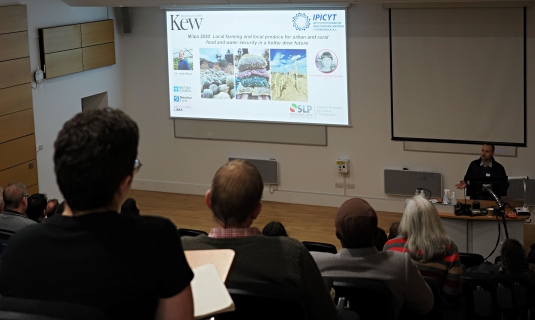
Dr Casper Chater, from Kew Gardens, gave a very interesting overview of his work on the factors that affect the density of stomata, the structures that control gas exchange and transpiration. By altering stomatal density, it’s possible to develop varieties of wheat, barley and rice that are more resistant to drought and high temperatures. Dr Chater also told us about a more recent collaboration with scientists and farmers in Mexico, which centres on developing nitrogen-fixing legume crops that are better equipped to deal with climate change.
Our final speaker, Dr Chris West, spoke about work carried out by the Stockholm Environment Institute at the University of York, and his use of model-based systems to tackle food security issues. In a very lucid talk, Dr West explained the impact of environment and socioeconomic factors on food production, with in-depth examples on agricultural-driven deforestation and effects on biodiversity and the direct and “cross-border” impacts of climate change on food security.
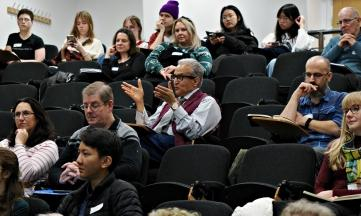
All of the talks attracted many questions, no doubt a reflection on the quality of the speakers and the interest of the audience!
Dr Lynda Partridge FRSB
Lady Mary Wortley Montagu: Medical Pioneer
20 July 2022
Back in 2019, the RSB Yorkshire branch were planning a Pioneers of Biology event to celebrate Lady Mary Wortely Montagu, who has connections with the Barnsley area. Lady Mary introduced the first successful treatment for smallpox by inoculation in Britain in 1721, some years in advance of Edward Jenner (1796). The branch had envisaged a live event at Wentworth Castle Gardens in July 2020, but unfortunately (if topically), the COVID-19 pandemic intervened. Whilst we still hope to hold a face-to-face event in the future, in the interim, Jennifer Rudd, a history guide for the National Trust at Wentworth Castle Gardens, very kindly volunteered to give a virtual seminar on the remarkable life and achievements of Lady Mary.
Jennifer gave a fascinating talk, detailing not only Lady Mary’s biography, but also providing us with an insight into the medical world of the early 1700s and the horrors of smallpox. Lady Mary was an early feminist, and although self-educated, she was clearly something of a polymath and a great communicator. Crucially, she was also open to new ideas. Whilst in Turkey with her diplomat husband, Lady Mary came across the technique of inoculation, routinely practised by local women to protect against smallpox. (At this point, Jennifer gave a lively demonstration of the technique using a walnut, Dijon mustard and an upholstery needle!) Having suffered smallpox first-hand, Lady Mary was keen to protect her children against this terrible disease, and on her return to Britain made great efforts to popularise inoculation. This ultimately led to the first successful clinical trials for the technique.
Unfortunately, during her lifetime, reactions to Lady Mary’s achievements were mixed, with many “professionals” showing disdain for her involvement. Consequently, British history has rather neglected her important role in the fight against smallpox. With assistance from the Royal Society of Biology, we hope to help rectify this!
Dr Lynda Partridge FRSB
Frontiers of Sciences VI
12 March 2022
Frontiers of Sciences is one of the pride and joys of the RSB Yorkshire branch’s annual science-in-society events. The sixth event took place online on 12th March 2022 and was held in association with the Astrobiology Society of Britain (ASB), the Royal Society of Biology (RSB) Yorkshire branch, the Royal Society of Chemistry (RSC), and the Network of Research on the Chemical Evolution of Life (NoRCEL).
Since the event was still impacted by COVID-19 travel restrictions, we decided to take the opportunity to invite all the speakers from further afield. These were Dr Margareta Segerståhl, principal scientist at Bisari Research Institute, Helsinki, Finland who delivered an oral presentation entitled “A New Way of Describing the Cell”; Professor Tadej Kotnik, University of Ljubljana, Slovenia addressing the issue of the “Role of Abiotic Horizontal Gene Transfer—Currently and Throughout Evolution”; Professor Josep M. Trigo-Rodriguez, Institute of Space Sciences (CSIC-IEEC), Barcelona, Spain who talked about “Early Protoplanetary Disk Chemistry Preserved in a Xenolith, Discovered in the CR Chondrite Lapaz Icefield (LAP) 02342”; and finally, Professor Sávio Torres de Farias, Federal University of Paraíba, João Pessoa, Brazil who delivered a talk on “What can tRNAs Tell us About the Organisation of Biological Systems".
Since the event was online only, we had more of an international flavour to the meeting. There were 24 nations represented, with a total of 107 registrants on the eve of the event, with a further half dozen registering during the meeting. Of this, 60 people logged on for the duration.
The UK had the highest number of registrants at 59, and the remaining were from the rest of the world. In terms of global north (13 nations) and global south (11) were almost 50/50 split. It was clear that a good number of participants had attended previous Frontiers of Sciences meetings in person, and therefore, going forward, the March 2023 Frontiers of Sciences VII will be a live event.
Dr Sohan Jheeta FRSB
Visit to the Himalayan Garden and Sculpture Park
21 May 2022
36 members and young people gathered in the late morning on a fresh spring day for an introduction and visit at the Himalayan Gardens in the Yorkshire Dales at Grewelthorpe near Ripon. The gardens and sculptures have become even more spectacular since our last visit several years ago and have now developed to the boundaries of the 45 acre steep-sided valley location and include a pagoda, summerhouse, norse hut, contemplation circle and Himalayan shelter, together with three lakes and decorative bridges.
The visit began with coffee and an introduction in the new Learning Centre; this presentation was given by one of their younger gardeners who outlined the learning opportunities for someone who joined the horticultural team only 2 years ago and some of the challenges of maintaining the site, such as the felling of hundreds of larch due to fungal disease.

This was then followed by walks around the garden in small groups to see the North of England’s largest collection of rhododendrons, azaleas and magnolias, totalling 20,000 plants together with 90 contemporary sculptures in stunning woodland and gardens. The lush microclimate accommodates the rare blue himalayan poppy (Meconopsis) and a wide range of ferns.
Chris Collins MRSB
The elements of life and medicines
27 April 2022
This event was one of a series of annual evening seminars run by the Yorkshire Branch of the Royal Society for Biology and the Central Yorkshire Section of the Royal Society of Chemistry, focussing on research at the interface of biology and chemistry. It was good to be back to a live event in the Department of Chemistry at the University of York after 2 years absence!
Professor Peter Sadler, University of Warwick, is an inorganic chemist who conducts research at the interface of chemistry, biology and medicine. His research group is exploring the use of metals in medicine, including for the treatment of cancer, viral diseases such as HIV, and as a constituent of novel antibiotics.
Professor Sadler is an eminent scientist, a Fellow of the Royal Society of Chemistry, and a very entertaining speaker. He started by asking the audience which elements were essential for life and then took us on a very enjoyable romp through the Periodic Table to try to answer this question. Some of his conclusions were surprising, with certain elements (e.g. silicon) being included in health supplements, but with no evidence to show that they are actually required by humans. Other elements, whilst not needed to sustain life, are very useful in medicine (e.g. platinum compounds in treating cancer). Professor Sadler illustrated his talk with imaginative use of props including cereal packets, bottles of vitamins and bursting balloons. The audience was clearly receptive and engaged, as reflected in the number of questions from both biologists and chemists at the end of the talk.
The Yorkshire Branch would like to thank Dr Derek Wann and his colleagues from the Department of Chemistry in York for organising the seminar and refreshments this year.
Dr Lynda Partridge FRSB
Meet the RSB Yorkshire branch committee
11 October 2021
We decided to host this event with two goals in mind: To attract interest and potentially membership for the RSB and our committee, and to demonstrate our committee’s diversity. Our aim was to target students who are considering biology careers, particularly those who may not have heard about the RSB. Ultimately, we wanted this event to be informative and inspiring.
It started with a presentation where I introduced the RSB before talking about the committee. I introduced the Yorkshire committee covering their sectors, and what they do in their daily lives. One of the things we wanted to demonstrate is that there are a range of biology careers other than the traditional academic pathway.
We ran a Slido poll to understand our audience: whether they were students, what qualification they are studying for or they recently graduated with, if they were RSB members, or were interested in becoming one. Following this, a selected few committee members gave talks about themselves and their career evolution. We made sure that those who spoke were from a range of different backgrounds and sectors, and that we had an equal split between men and women. After a short break, the floor was opened for discussion.
The Slido poll revealed that our audience were mostly college, secondary school and university students who wanted a biology career, and were already RSB members. The discussion however became more about helping people towards a biology career rather than inspiring them to take up biology.
Despite this re-direction, the discussion was lively as conversations in the chat took place alongside the main discussion. Nevertheless, the key message that came through distinctly from this event is that a biology career isn’t a linear path. Instead, there are many twists and turns.
Dr Danae Dodge MRSB
Naturally nano – Exploiting magnetic bacteria for nanotechnology and biomedicine
28 April 2021
This was one of a series of annual joint seminars run by the Yorkshire branch of the Royal Society for Biology and the Central Yorkshire Section of the Royal Society of Chemistry, focussing on research at the interface of biology and chemistry. The seminars are usually delivered live at the University of York and this online talk replaced one that was cancelled due to COVID-19 in April 2020, before we were quite so au fait with holding online events!
Dr Sarah Staniland is currently a reader in bionanoscience in the Department of Chemistry at the University of Sheffield and started her talk by outlining her career path. It was heartening to see that it’s possible to combine good research with teaching and having a family.
Dr Staniland then gave an excellent overview of her research on magnetic nanoparticles. Such nanoparticles have applications in biomedicine (e.g. in diagnostics and cancer therapy) but also in nanotechnology. For all of these applications, uniform size and shape is key and as is often the case, we can learn much by studying bacteria that have naturally perfected making magnetic particles known as magnetosomes.
Dr Staniland described promising research using natural and derivatised magnetosomes in tumour models. She also described various approaches for “mimicking” the processes used by bacteria to synthesise magnetosomes in a green, environmentally friendly way in the laboratory. Some of these approaches may be applied to design novel proteins for use in nanotechnology (e.g. data storage).
The online seminar was a very good substitute for the live event and probably reached a wider audience, although some of us did miss the refreshments traditionally served beforehand! We’ll certainly be interested in trying to hold “hybrid” events in the future, so that those who can’t travel to a live venue can still join in the experience.
Dr Staniland’s talk is available on the RSB YouTube channel.
Dr Lynda Partridge FRSB
Autumn Symposium “Beyond Test Tube Babies: Harnessing the Assisted Reproductive Technologies”
14 November 2020
When Dr Emma Jones first suggested this theme, we envisaged that the event would be held in a lecture theatre at the University of Sheffield. Unfortunately, the Covid-19 pandemic intervened and we found ourselves planning our first-ever virtual symposium!
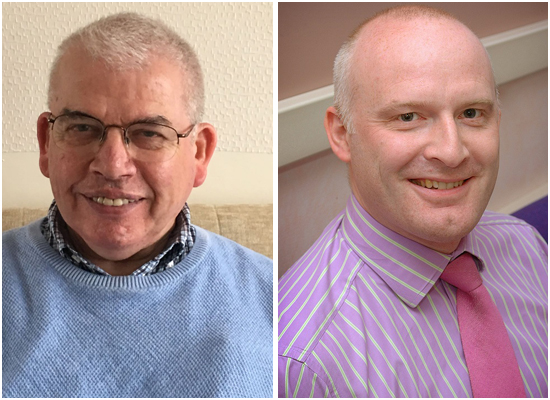
Professor Bill Holt (left) and Professor Allan Pacey (right)
Some of us viewed this with trepidation, but thanks to Emma’s careful organisation and expert assistance from central RSB (especially Harriet McAra), the meeting was a great success, with more than 70 people registering. We had two excellent presentations from experts in their fields.
"Can we support wildlife genetic diversity using reproductive technology? What about species that are already extinct?" Professor Bill Holt, visiting professor, Academic Unit of Reproductive and Developmental Medicine University of Sheffield and honorary research associate, Smithsonian Conservation Biology Institute, Washington DC.
In the first presentation, Professor Holt gave a fascinating account of the current uses of reproductive science techniques to support the survival of wild and captive species. We were told about the non-invasive technique of faecal sampling, which allows monitoring of fertility cycles, sex ratios and pregnancies by measuring hormone levels.
This approach has been successful in helping the conservation of Mohor gazelles in captivity in Spain, whilst in Canada it has even been combined with DNA analysis to allow monitoring of individual caribou in wild populations.
Professor Holt also spoke about the more familiar technique of artificial insemination, which has been used to improve the genetic diversity and survival of the black footed ferret, a species brought back from the edge of extinction in the US.
In perhaps the most famous example, the giant panda in China, we learned that natural mating may give the best results, provided that detailed studies on endocrinology, social behaviour and mate choice have been undertaken.
After hearing about widespread attempts to conserve amphibians under threat from the fungal infection, chytrid, Professor Holt turned our attention to the more controversial area of “de-extinction”. In theory, using the latest reproductive techniques (e.g. cloning), extinct species such as woolly mammoths or the Tasmanian wolf might be brought back to life. Of course, this raises a large number of important ethical and biological issues, which really need to be addressed. Perhaps fortunately, such approaches have so far met with very limited success.
"Male infertility: do we have a sperm crisis?” – Professor Allan Pacey, Professor of Andrology, Department of Oncology and Metabolism, University of Sheffield.
Professor Allan Pacey gave an entertaining and interesting presentation on male fertility. Although human sperm were first visualised using a primitive microscope by Anton von Leenwenhoek, a Dutch draper in 1678, it appears that studies on male fertility have been very much neglected since.
Professor Pacey suggested six convincing reasons for increased research into male fertility: a gradual decline in sperm count in recent years (at least in the West), the increasing age of paternity, the increased incidence of sexually transmitted diseases, increased rates of testicular cancer, poorer general health in men with known fertility problems and the findings from surveys that suggest young men are having less sex than in previous generations. In addition, in 30 - 50% of cases where couples have difficulty conceiving, the problem can be attributed to deficiencies in sperm production.
After describing sperm physiology and development, Professor Pacey addressed treatments for male fertility that include artificial insemination (AIS), in vitro fertilization (IVF), intracytoplasmic sperm injection (ICSI) and the use of donor sperm.
Finally, although there are few obvious lifestyle factors that affect sperm number/health, Professor Pacey presented data from a very recent publication by his group that indicates that looser underwear and lycopene (found in cooked tomatoes) can be beneficial.
Both talks led to a number of interesting questions, indicating good audience participation, although we missed being able to give the speakers the applause they deserved!
Dr Lynda Partridge FRSB
Autumn Symposium "Clean Water"
16 November 2019
As the human population continues to grow, water pollution is a major global problem that affects our own health and that of our aquatic ecosystems. This symposium addressed the problems faced in maintaining “clean water” in the 21st century and ongoing research that may offer potential solutions.
Professor Lorraine Maltby (University of Sheffield) gave an excellent introduction to the topic, explaining the value of fresh water ecosystems to our wellbeing, and current threats to these including changes in land use, climate change, pollution and invasive species. Of some concern, the EU Water Framework Directive reported that 86% of UK rivers failed to reach “good” ecological status in 2016. Professor Maltby illustrated her talk with examples of her own research carried out in Sheffield and other parts of Yorkshire, including the recently infamous village of Fishlake.
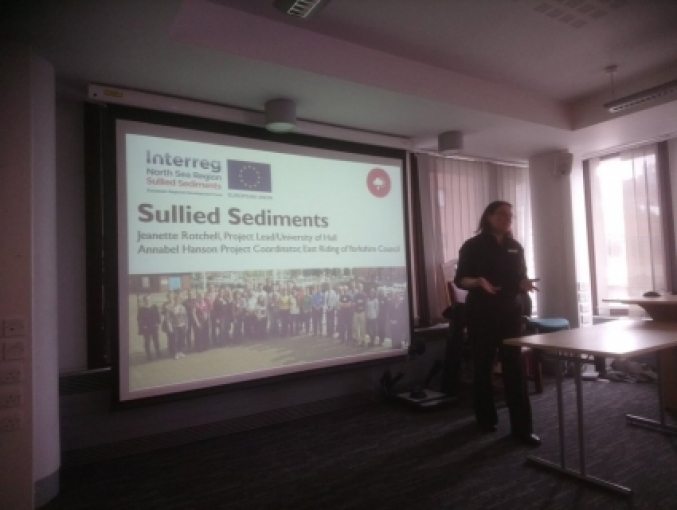
Three shorter talks followed, all from researchers based at the University of Hull engaged on the Sullied Sediments project. As Project Lead, Professor Jeanette Rotchell introduced this exciting initiative, which has 12 partners including public, private and voluntary sector organisations in the UK, Germany, Belgium and the Netherlands. Sullied Sediments is developing and testing new tools to assess, treat and prevent contamination from pollutants found in the sediments in our waterways. Dr Andrew Bowa described fascinating research using natural pollen particles that act like tiny sponges to take up drugs and chemicals, and which may be used for water treatment. Samantha Richardson, a PhD student on the project, spoke very eloquently about her work in developing paper-based devices that were simple enough for volunteers to use to assess pollution in local waterways. This citizen science approach is helping to engage the local community with the issue of “clean water”.
Over the lunch break, participants were treated to interactive demonstrations of research being carried out at the University of Hull. These proved so interesting that some attendees had to be reminded that the talks were about to start again!
Natalie Lamb, (Anglia Water/University of Sheffield and also Chair of the RSB East Anglia Branch), gave a very lively and entertaining talk about her PhD research, which is aiming to reduce or eliminate the chemicals that are added to our drinking water. The audience were particularly interested to see photographs of the artificial pipe system that Natalie has built in a shipping container to facilitate her work.
Finally, Dr Pattanathu Rahman travelled all the way from the University of Portsmouth to presented case studies of his research on using biotechnological approaches for dealing with metal pollutants in water. He delivered a tantalising glimpse of the possibility of using microbes to convert waste contaminants such as iron oxide into valuable products.
Despite some attendees having to cancel due to local flooding, this was a very successful and obviously highly topical symposium that generated considerable lively debate. The branch is very grateful to all of those in Hull who helped in hosting this event.
Dr Lynda Partridge FRSB
Frontier of Sciences IV
16 March 2019
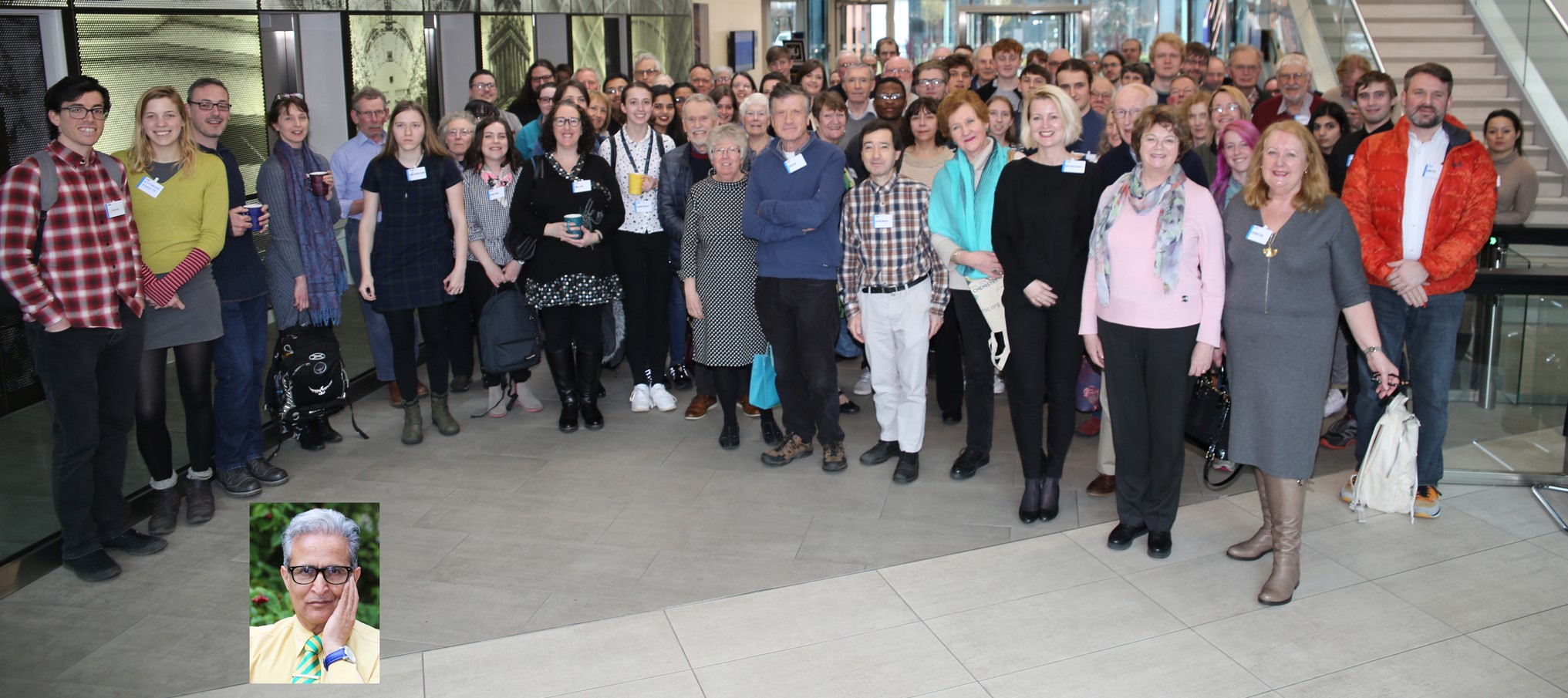
This year’s selection of talks was delivered by our first ever all female panel: Dr Frances Westall of CNRS, France, Professor Christine Foyer FRSB of University of Leeds and Dr Klara Capova of Durham University.
The topics delved into a wide spectrum of scientific knowledge and study including volcanic rocks, hydrothermal vents and the origin of life; antioxidants and redox and sensing mechanisms and, the ultimate question of what is life and where do we come from?
As in previous years, Dr Sohan Jheeta organised and promoted the event with sponsorship from the Royal Society of Biology; the Astrobiology Society of Britain; and the Royal Society of Chemistry as well as, for the second year running, the generous donation of the excellent state-of the art venue by KPMG.
This year’s meeting was very well attended, with our audience exceeding 100. Over 60 people took time to complete feedback forms which were extremely encouraging – indicating that, overall, the audience was happy with the choices of subject matter, presentation and quality of visual materials, this despite the public address system not functioning properly!
Next year, in order to further extend the reach of the event, Dr Jheeta will sponsor one “scientific fringe” speaker who can deliver a talk on a subject not necessarily covered by the mainstream (e.g. nano-robotic exploration of outer space) and which would be outside the traditional societies’ scope. This should invigorate the meeting and encourage an even greater participation by the public.
The future of these Frontiers of Sciences meetings is looking extremely bright.
Dr Sohan Jheeta FRSB
Symposium on Ancient DNA and AGM
10 November 2018
Ancient DNA (aDNA) is a field that has revealed so much already about our evolutionary genetic past and that of other species, especially when combined with other archaeological scientific disciplines. We therefore found it pertinent to theme our symposium this year on this subject, held at the University of Bradford.
Our social media officer Dr Danae Dodge opened the symposium with a brief introduction to aDNA. We then heard from four speakers that illustrated the breadth of the field.
First, Mrs Keri Brown (Manchester Interdisciplinary Biocentre) presented case studies that emphasised the differences between the key technological revolutions of the field. Also from the same institute was Professor Terry Brown, who spoke about how aDNA can be used to study past diseases. After lunch, while our members convened for our AGM, the rest had the opportunity to get a tour of the Bradford archaeological department.
We then resumed the symposium with Dr Philip Murgatroyd (University of Bradford) talking about the Lost Frontiers- the multidisciplinary project that aims to study the past environment of Doggerland.
Lastly, Dr Eva Fernández-Domínguez (University of Durham) explained what aDNA can tell us about the people that spread farming throughout Europe.
Overall the symposium was a success with discussions spilling out of the lecture theatre into the breaks, and the audience was diverse; ranging from the public, biologists of course, other scientists and even other aDNA researchers.
Finally, we would like to thank the speakers for giving their time, Jamie Moloney who (while he attended in a personal capacity) put up a Yorkshire Wildlife Stand, the University of Bradford especially Dr Steven Picksley for hosting the symposium, Dr Lynda Partridge for facilitating the day, and the volunteers Meg Graham and Tracey Chapman.
Dr Danae Dodge MRSB
Four Societies Joint Meeting: Frontiers of sciences II
10 March 2018
Repeating the success of 2017, our third joint society meeting in Leeds again proved to be a well-attended and popular affair. Thanks to the extremely generous KPMG, who donated their state of the art lecture theatre as well as many other services, the venue turned out to be an impressive location for the event.
The original sponsors, the RSB, and the Royal Society of Chemistry, were joined this time by the Astrobiology Society of Britain and the Royal Astronomical Society, ensuring that a wide spectrum of science was covered. Thanks also go to the organisers who ensured 70 keen and enthusiastic attendees on the day, despite the appalling weather.
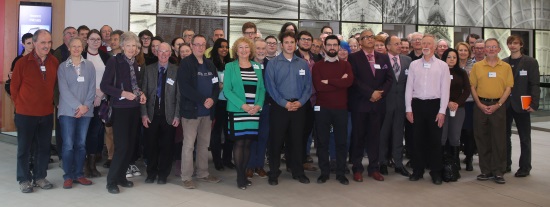
Once again, we were able to recruit some excellent speakers to the cause: Dominic Papineau of UCL, whose subject was ‘Bio-signatures in the Eoarchean rock record’; Peter Stazewski of Université Claude Bernard Lyon 1, who talked about ‘the chemist's challenges of the future: how to animate dead matter’; and Sergio Ioppolo of Queen Mary University of London, who discussed ‘the star formation process’, with emphasis on the several physical and chemical steps.
Unfortunately, our 4th speaker Frances Westall of CNRS Orleans Campus had to cancel at the very last minute due to severe illness, but Dr Sohan Jheeta stepped into the breach and delivered a presentation on ‘recent advances towards the origin of life’.
Feedback data was collected after the session, together with interesting and positive comments, encouraging us to maintain this annual event.
Dr Sohan Jheeta FRSB
Joint seminar on the origins of life
18 March 2017
Meeting sponsored by RSB, Royal Society of Chemistry and the Institute of Physics
Following the inaugural tri-society meeting in 2016, this years event proved even more successful, with over 80 attendees coming from as far afield as Newcastle, Liverpool and Manchester, with a sizeable contingent hailing from across Yorkshire.
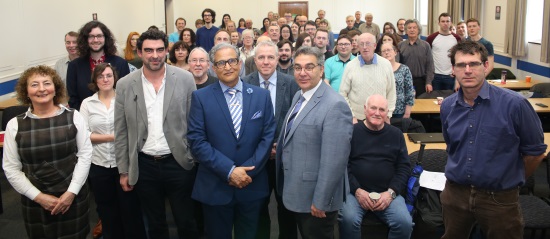
That the meeting attracted such large numbers is testament to the quality of the speakers and also that it was held in the easily accessible Parkinson Building at Leeds University. The audience was satisfyingly diverse, ranging from 6th formers through experienced academics and the general public, who were both fascinated and inspired by the thought provoking topics.
Some excellent and positive feedback came out of the session, which encourages us to organize similar events annually. Many thanks to our fantastic speakers:
Elias Chatzitheodoridis, National Technical University, Athens, spoke on Martian meteorites and the physicochemical conditions that produce niche environments for chemical evolution of life; Mark J Burchell, University of Kent, spoke on organic materials delivered from space; and Nick Lane, of University College London, spoke on the origins of heredity in protocells.
It was a very interesting day, and great to have longer lectures to fully explore subjects. “I’ve been inspired to investigate several subjects further in order to find a suitable research topic for my future career” said one attendee. Another commented: “I found the symposium very interesting, even as a law student. I would like to congratulate all the speakers and to say that these kinds of symposiums improve the general knowledge of everyone from different areas of study.”
Dr Sohan Jheeta FRSB
York Birds Of Prey Centre visit
19 June 2016
 Two dozen branch members and guests gathered to enjoy falconers demonstrating their art, enthusiasm and extensive knowledge of birds of prey. The York Birds of Prey Centre holds over 80 different raptors, and a range of birds were presented to our group including a fledgling Chilean Blue eagle taking its first steps, hawks, barn owls and a magnificent Golden Eagle. Much of the time was spent hearing about the birds, interacting with them up close, and watching them fly amongst us. Seeing a Golden Eagle up close is just unforgettable.
Two dozen branch members and guests gathered to enjoy falconers demonstrating their art, enthusiasm and extensive knowledge of birds of prey. The York Birds of Prey Centre holds over 80 different raptors, and a range of birds were presented to our group including a fledgling Chilean Blue eagle taking its first steps, hawks, barn owls and a magnificent Golden Eagle. Much of the time was spent hearing about the birds, interacting with them up close, and watching them fly amongst us. Seeing a Golden Eagle up close is just unforgettable.
Dr Steven Picksley FRSB
Astroscience Meeting
23 April 2016
This maiden Astroscience Meeting - a new venture involving collaboration between the members of the Royal Society of Biology, the Royal Society of Chemistry (RSC) and the Institute of Physics (IOP) was held on Saturday 23rd April 2016 at the University of Leeds.
To begin, Dave Waltham asked 'Why is the Sun so Big?' His new research showed that the Sun, although larger than 95% of its neighbours, is the optimum size for formation of inhabitable zone which permits life to have arisen on any of its planets. This being in spite of the fact that smaller stars last much longer and therefore a randomly selected inhabited planet is much more likely to orbit a small star.
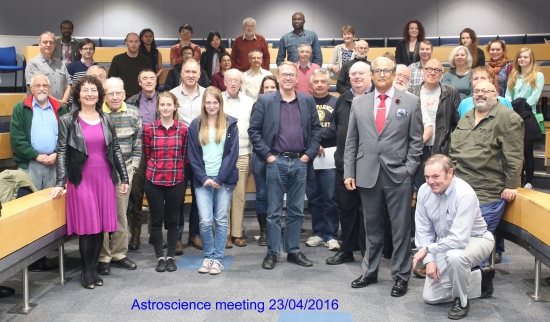
Group photograph with speakers Professor Dave Waltham, Royal Holloway; Dr Mukesh Bhatt, Birkbeck College; Professor Martin McCustra, Heriot Watt and the Chairs of the RSB, the RSC and the IOP (Professor Val Randall, Dr Christine Rogers and Dr Mike Ries)
Mukesh Bhatt followed with a discourse on how the newer and constraining definitions of life provided by astrobiology are likely to have a clear impact on the way legal and ethical decisions are made. The issues he brought to light involved the difficulty in actually defining 'life' (since despite drawing on all available religious, philosophical and scientific knowledge – there is still no cohesive or formal definition of what life actually is). The meaning of personhood in particular may well be applied to extremes.
Finally, Martin McCoustra, in his talk entitled 'Stars 'r' Us' highlighted the details of the rich chemistry that exists in space, describing the essential role of the chemistry in the universe which was then delivered onto the Earth to kick-start life. The deficiencies and drawbacks of gas phase chemistry were also explored along with the crucial role played by soot and stoor in developing the chemical complexity of the universe.
Dr Sohan Jheeta MRSB
Wentworth Castle Gardens
16 August 2015
The branch's visit to Wentworth Castle near Barnsley was well attended. Our volunteer expert guide described the history of the only Grade I listed gardens and parkland in South Yorkshire and the £15m restoration of it since 2001, with its 26 listed structures, including a full-sized mock castle.
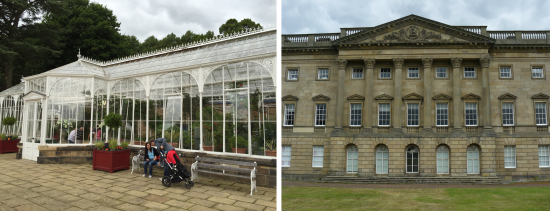
Politics and family rivalry led to the Grade I listed house being built in 1764 in competition with nearby Wentworth Woodhouse. In 2003, its Grade II* Victorian conservatory was an unsuccessful competitor on the BBC's Restoration programme, but the initiative to restore its former glory succeeded only in 2013, at a cost of £3.7m.
Our guide spoke of the challenges resulting from the gardens and parklands' varied ownership, including some improvements in private ownership in the 20th and early 21st centuries, some limited recovery of some garden features by the local authority after 1948, then restoration by Wentworth Castle Heritage Trust since 2001.
We heard about the contradiction between objectives of the grants that funded restoration and the limited resources and skills available for maintenance by volunteers and a tiny staff of employees compared with the 18th century.
In the afternoon, the branch's Chris Collins described the work of Lady Mary Wortley Montagu, commemorated by an obelisk in the gardens. Wortley Montagu was famous for introducing a smallpox inoculation ('variolation') into England 75 years before Jenner developed the cowpox vaccination in 1796.
Chris Collins MRSB
Summer Outing
12 July 2014
Through a clearing sea fret (coastal fog), Yorkshire branch members arrived at the Yorkshire Wildlife Trust’s Living Seas Centre at Flamborough South Landing. After an introductory talk by our host and guide Ant Hurd, the Centre’s manager, the group went down to the shore on a retreating tide.
The sea fret also retreated off shore to reveal the magnificent chalk sea cliffs of Flamborough Head, rising to 400ft in places, which were to be the centrepiece of our day. The very low tide allowed us to look at pretty well all the classic shore zones and seaweeds and to rummage in rock pools. Among the finds were a very well camouflaged flat fish, the solitary sponge Sycon ciliata and an enraged (to the startlement of one member) swimming crab (Necora puber).
View more photos from the outing
We saw evidence in the Living Seas Centre of much larger denizens of the deep passing by – with recent records of whales and dolphins and porpoises along the Yorkshire shores up to Whitby.
On the top of the cliffs with sunshine above and the fret well out to sea, Keith Clarkson, site manager at RSPB Bempton Cliffs led the group on a guided walk of the best viewpoints. We saw ample evidence to back its claim as “the best place in England to see, hear and smell seabirds”. The place is home at times to over 200,000 seabirds including gannets, razorbills, guillemots, kittiwakes, puffins and fulmars. Despite some of these having departed after breeding there was still plenty to see, hear and certainly smell. There were some good questions, such as “why is a Guillemot’s egg that shape?” The answer is that it appears to stop them rolling off the cliff.
At the end of the day, the more adventurous put to sea from Bridlington to view the bird colonies, cliffs and stacks, whilst the timid and elderly went home looking for a restorative and a rest after a grand day out.
Mike Smith CBiol MSB (with material and photography from Jane Pottas)
Spring Retired Members Lunch
6 March 2014
Twenty-two members and their guests gathered at 'The Food Academy' restaurant, in Leeds, for their regular, biannual, lunch. The restaurant is now well-established and is located on the expanding 'Printworks' campus of Leeds City College. The purpose of the restaurant is mainly training students who intend on working in the catering industry.
Supported by the Society of Biology, those present at this time enjoyed an excellent meal, served and prepared by well-trained staff. Attendees included those mostly from the Yorkshire branch area but also came from the neighbouring East Midlands branch. It was an occasion for both renewal of old acquaintances and the making on new ones.
I was particularly pleased to see several new patrons present. The relaxed atmosphere of the meal provided the opportunity for engaging conversation and for the exchange of mutually interesting anecdotes. All this was enhanced by, as one guest put it, "access to some very good, locally brewed, ale". I would recommend this event to anyone who is eligible and, in particular, anyone who has yet to try it.
Barry Canham CBiol MSB
Food, Glorious Food
16 November 2013
A summary of talks from our Annual Symposium entitled "Food, Glorious Food – what do we need, how do we keep getting it and how safe is it?"
Dr Wayne Martindale, Sheffield Hallam University
A world population of 9 billion people by 2050 will lead to a reduction of protein from animal sources. Dietary protein will be maintained by other means such as the fungal protein product 'QUORN' that has a lower carbon footprint than other protein sources. There will be massively less food wastage in the home, by retailers and processors and there is likely to be food more tailored to individuals. Better planning of meals and the use of frozen foods has been demonstrated to significantly reduce food waste.
Professor Tim Benton, UK Global Food Security Champion, University of Leeds
Global food security is not just about preventing starvation but also about ensuring peace as "Everyone is only 9 meals away from anarchy."
1) The human population is growing
2) Much of that population is getting richer ("Richer people eat more.")
3) Increasing urbanisation and remoteness from sources of food.
Waste and over-consumption are perennial problems: the food waste generated by Europe and North America is equivalent to the whole food production of sub-Saharan Africa whilst over-consumption / obesity cause 20% of deaths globally.
Action is needed at international and national level to minimise risks and maintain food supplies. We should also learn to change our diet and only "eat meat as a treat".
Dr Eric Ober, National Institute of Agricultural Botany, Cambridge
Yields of cereals are increasing slowly, but over the last few years there have been signs of stagnation so breeding programmes continue. Newer breeding programmes use genes from wheat ancestors to produce a 'super-wheat' to provide better resistance to drought, heat and disease. There is still a role for older varieties and Dr Ober described experiments on the optimisation of conditions for growth and yield by looking at limiting factors, such as water supply and light levels with these. There is a considerable gap between experimental and farm yields (the 'yield gap'), so farming practice needs to improve to realise that potential.
Dr Qasim Chaudhry, Food and Environment Research Agency, York
Use of nano-technology will lead to lighter weight, more hygienic and 'smarter' packaging that will allow longer shelf-life and less waste. When the packaging includes nano-particles it will be able to detect spoilage making the 'use by' date redundant. Other applications lead to simpler diagnostics in veterinary practice and agricultural use e.g. pest control uses both in diagnosis and as a carrier system for insecticides. There remain some concerns about nano-particles in the environment.
Dr Martin Hemmingway, ALcontrol Laboratories, Rotherham
'Horsegate' earlier this year reminded everybody just how difficult it is to be sure of what they are eating. But contaminants can be distinguished and even traced to their origin by techniques routinely used in analysis. These include the antibody/protein technique ELISA (Enzyme Linked Immunosorbent Assay), PCR (Polymerase Chain Reaction)/DNA techniques and Stable Isotope Analysis.
Michael Smith MSB
Retired Members Lunch
7 November 2013
This lunch was at a novel venue, the Old Print Works in Leeds, which is the new home of Leeds City College. Only opened 6 weeks before, the restaurant is in a newly built part of the campus which has better access and car parking compared to the previous site. The surroundings are very pleasant, and a Leeds Brewery hand drawn Pale Ale went down very well.
Unusually, the meal was a la carte, as the restaurant is now open for meals from breakfast, through lunch, high tea and early evening. Disappointingly only 12 attended, but all enjoyed their meal, once the fish cakes that turned out to be Scots Eggs were returned to the kitchen! Despite service being a little slow (as judged by a few, I like eating French style and we meet to discuss biology and other matters of mutual interest) the food was both excellent and interesting. The college gave a very reasonable discount because of these problems (a baked Alaska turned over in the kitchen!).
The next meeting will be Thursday 27th March 2014 at 12:30. Usually, there has been a good improvement in service after the additional months of training. It is likely that a set meal with choices will be arranged for that meeting. Recommended!
Paul Bartlett MSB
Explore the shore day at Boggle Hole
5 October 2013
A successful "Explore the Shore" day at Boggle Hole was led by Jane Pottas and Paula Lightfoot. Boggle Hole Youth Hostel was the venue for the day and managers, Andy and Peta Nugent, and their staff could not have been more hospitable.
The Hostel is conveniently situated only a stone's throw from a pristine rocky shore. Fourteen members took part, including individuals and families and a couple of dogs. They enthusiastically searched out species to identify on the shore and back in the classroom at the hostel.
Approximately 100 species were identified including a stalked jellyfish, several species of fish, snails, bryozoans and over 30 seaweeds. All records for the day will be uploaded to the National Biodiversity Network database.
The weather was wonderfully warm and sunny, everyone had a good time and we all learnt something new about this fascinating environment. More days on the shore are on the cards.
Jane Pottas
AGM with Royal Society of Chemistry
29 May 2013
Professor Tony Hardy, chair of the European Food Safety Association (EFSA) scientific committee gave an illuminating lecture entitled: European Food Safety a Biologist at Large.
Food crises of the 1990s meant it was necessary to set up national Food Standard Agencies in European countries. Professor Hardy described the decision making framework and the role of chemicals in food production. Pesticides are intrinsically poisonous and therefor pose a risk to consumers, bees and other fauna which may have knock on effects on the food chain.
The EFSA was set up in Brussels in 2002. Their remit included risk assessment, risk communication and independent scientific advice. The EFSA collects information independently, looks at evidence and communicates risk assessment. They oversee topics such as plant health, contaminants, animal food, animal welfare, food additives and novel foods.
Professor Hardy then described the ways in which data are presented showing toxic effects and the levels at which there is no response. Outcomes can be variable but there are several hot topics including chemicals that have an effect on the endocrine system such as: Bisphenol, Aspartame (because of its inclusion in soft drinks). Others topics include cumulative risk exposure, uncertainty, animal cloning, genetically modified organisms and food health claims.
Food safety is a top priority and there is no such thing as a zero risk.
To find out more check out the EFSA website and subscribe to their Highlight magazine.
Jennifer Burnett CBiol MSB
Himalayan garden and sculpture park
18 May 2013
The 2 month long drought in Yorkshire had ended a little earlier in the week, so 21 intrepid members and guests crashed through some deep floods and heavy rain to reach the Himalayan garden, located at an altitude of 850ft. at the "Head of the Valley" (Hutts).
Following a welcome refreshment break, Hannah briefly introduced the park. When the new owner decided to build a garden there was a period of intense removal of "Super ponticum" (the native invasive rhododendron) and Japanese knot weed. Although planting only began in 1998, because of high rainfall and acid soils (between ph 4 and 6), establishment of the Rhododendron, Cornus, Azalea, Camellia, Pieris and others was rapid. There are now over 1000 varieties of species and Hybrid Rhododendron, with many plants being grown from seed collected on recent plant hunting trips to the Himalayas, China and Korea.
Leopard by Hamish Mackie at Himalayan garden and sculpture park, Grewelthorpe © Paul Bartlett
Fortunately, following a while admiring flowering plants in the nursery area, with some plants being purchased, the storm passed and the magnificence of this north facing garden could be explored at will. The late spring meant that many Narcissi were still in abundance but, unfortunately, many of the larger plants had only flower buds. Unexpected to many of us, was the excellence of the 54 sculptures, all beautifully displayed, some in the open others partially hidden by the planting. Almost all were influenced by biological forms, from naturalistic prowling leopard, guinea fowl and roebuck to stylised steel mushrooms, magnolia and stork. Very striking were a mosaic sycamore wing and a huge swift.
With the weather clearing there was more than enough for all of us to agree that this was a wonderful way to celebrate the "Fascination of Plants Day". The garden is only open for a few weeks in May and June, but we would recommend a visit to this magical landscape next year. Thanks to Chris Collins on the committee for the excellent arrangements.



